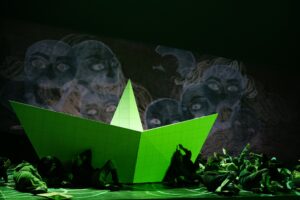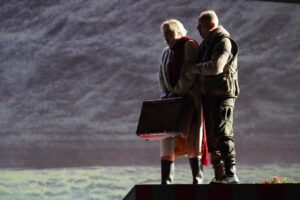If Vasco da Gama had not charted a sea route from Europe to India, the legendary Dutch captain Hendrik Van der Decken would not have found enough hubris in himself to force his sailors to battle a storm around the Cape of Good Hope. In 1487 the crew of a fleet led by Bartolomeu Dias refused to travel any farther to the east, and the rocky headland became known as the Cape of Storms. Yet King John II of Portugal, called the Perfect Prince, decided to reverse the explorers’ losing streak. The stretch of land jutting out into the ocean acquired a new name, “cabo da Boa Esperança”. As it turned out, the king was right. Vasco da Gama’s first expedition, financed by John’s successor, Manuel I the Fortunate, crossed the crucial point on 22 November 1497 and several weeks later found itself on the waters of the Indian Ocean. It returned to Lisbon in September the following year. The captain, despite losing over two-thirds of his crew and having to burn one of his ships in order to stop an on-board epidemic, was generously rewarded for his efforts. King Manuel made him an admiral and in an act of thanksgiving for opening access to the Indian treasures, he ordered the construction of a Hieronymites monastery near the port of Restelo.
It was from there that Vasco da Gama’s ships set sail. Sailors prayed for the success of the groundbreaking expedition in the local church, on the site of which the monastery with a new church, Santa Maria de Belém, was later erected. It was by the will of King Manuel that after the explorer’s series of successes the famous Torre de Belém was built in the Tagus riverbed, becoming a landmark for adventurers returning to the port and a symbol of Portugal’s maritime power. It was there that the huge building of the Centro Cultural de Belém was constructed to mark Portugal’s Presidency of the Council of the European Communities in 1992, including, in addition to conference and exhibition space, two concert halls with all the facilities. The bigger hall, with nearly 1500 seats, is a venue for operatic productions which cannot be presented – due to the large forces needed to perform them – in the historic Teatro Nacional de São Carlos.
Tómas Tómasson (Dutchman). Photo: António Pedro Ferreira
Before Van der Decken committed blasphemy in the middle of a storm off the coast of Africa and brought a curse upon his ship, he must have sailed around Portugal – perhaps even calling at the port on the outskirts of Lisbon, where the age of great discoveries began. I couldn’t shake off that thought as I travelled to a performance of Der fliegende Holländer half way between the anchorage where Vasco da Gama’s three-masters stood, and the sarcophagus holding his mortal remains. However, I went to Portugal primarily because of my personal fascination with the British approach to Wagner’s oeuvre. I wanted to confront my impressions of Negus’, Farnes’ and Elder’s interpretations with the interpretation of Der fliegende Holländer by Graeme Jenkins, a student of Norman Del Mar, a conductor who began his career as a French horn player and with time became famous for his solid and very insightful interpretations of Richard Strauss’ music. I was also looking forward to Peter Wedd’s belated debut as Erik, to another encounter with Peter Rose’s Daland and, last but not least, to live contact with the charismatic Icelander Tómas Tómasson as the Dutchman. I had previously heard him only once, in a performance of Tristan so dire that even his Kurwenal could not make much impression on me.
Jenkins is an extremely versatile opera conductor with experience in the Wagnerian repertoire. Associated with the Dallas Opera for nearly two decades, he prepared over fifty premieres for the company, including a production of Der Ring des Nibelungen, a project he embarked on when he was not yet forty. Jenkins knows the score of Der fliegende Holländer inside out. In 2014 he opened the season with it at Vienna’s Staatsoper: the production, which he conducted in place of Yannick Nézet-Séguin, went down in history because of Bryn Terfel’s phenomenal portrayal of the tormented wandering sailor. However, from what I heard in Lisbon, something keeps eluding him in this work, keeps leading him astray, into a labyrinth of intriguing textures and honed details from which no convincing picture of the whole emerges. Admittedly, Jenkins led the musicians with a relatively light hand, in calm, nicely measured tempi. He knew how to set the various parts within logically constructed sound structures, how to highlight meaningful motifs, to give room to the singers. Yet he was unable to maintain the pulse of the musical narrative, which in truly masterful interpretations of this opera resembles the rhythm of an exhausted heart: it flutters, faints, suddenly stops only to surge forward again in a moment to the point of breathlessness. Jenkins’ smooth, meticulously polished Holländer lacked contrasts. It was impossible to sense the sombre horror of immortality or the naive charm of redemption. Everything unfolded as if behind a foggy veil, in greyish twilight dulling not only the blackness of the ocean but also the sparkle in Senta’s eyes.
Scene from Act 3. Photo: António Pedro Ferreira
Perhaps I’m being unfair, perhaps Jenkins’ distanced interpretation simply did not match my sensibility, was against my idea of the true values of this ultra-Romantic opera. Under his baton the Orquestra Sinfónica Portuguesa played with evident enthusiasm, although – paradoxically – Jenkins was able to elicit more lyricism and subtle agogic hues from the wind instruments rather than from the strings, less sensitive to the conductor’s gesture. There was some excellent singing from the combined choirs of the Teatro Nacional, under the direction of Giampaolo Vessella, and the Coro Ricercare prepared by Pedro Teixiera. However, the narrative was carried primarily by the soloists. I have to admit that Peter Rose – still in fine vocal form – is becoming my favourite Daland, poignantly human in his weaknesses and authentic, though foolish love for his daughter. Excellent performances in the supporting roles came from Maria Luisa de Freitas (Mary) and Marco Alves dos Santos (Steersman), especially from the latter, a singer endowed with a lovely tenor, perhaps not sufficiently open in the upper register, but dos Santos was nevertheless able to use it to create a vivid portrayal of a young sailor, a little lost in the world of landlubbers. Peter Wedd, singing with a voice brighter than usual, but still perfectly supported and undoubtedly heroic, portrayed Erik as a brute, a man-boy immature for love, balancing on the fine line between aggression, manipulation and submissiveness. At times that portrayal was genuinely harrowing. Gabriela Scherer, who possesses an extremely lovely, meaty and colourful soprano, used lightly and with a great sense of phrase, at times felt constrained in her role as a passive Senta, which resulted in some minor intonation slip-ups and a somewhat dull sound in the middle register. As expected, Tómas Tómasson turned out to be the star of the evening, though, truth to tell, I would prefer to have heard him in the role a few years ago. His “black”, genuine dramatic baritone is already showing some signs of wear and tear, though it still manages to touch the very heart of the listeners. It is a powerful and yet subtle voice, perfectly even across the registers, wisely extended upwards from the bass range and not the other way round, as is the case with most of today’s Wagnerian bass-baritones. In addition, Tómasson has the looks for the role and is very convincing as an actor. In Lisbon he created a character as if straight from a film by Murnau, dark, exciting, with a great power of expression.
Gabriela Scherer (Senta) and Peter Wedd (Erik). Photo: António Pedro Ferreira
This year’s programme of the Teatro Nacional de São Carlos featured only two performances of Der fliegende Holländer, in a production by a young director, Max Hoehn, who got his first professional experience as an assistant to Graham Vick and David Pountney. A few months ago I grumbled about Paul Curran’s concept presented in equally difficult conditions of Bologna’s EuropAuditorium. I think I have to give him credit. When you have a limited budget, it is better not to have ideas than to have too many of them. Hoehn littered the space with a plethora of tacky props, equally tackily lit and complemented by downright infantile projections (set design and lighting direction by Giuseppe di Iorio, costumes by Rafael Mapril, projections by Amber Cooper-Davies). The whole seemed like a school play staged by a group of pupils at odds with each other. Instead of Daland’s ship – an oversize paper boat. Instead of a storm – chorus members doing a Mexican wave with chairs in their hands. If Erik is a hunter, let him run around the stage with a double-barrelled shotgun slung over his shoulder. If Senta is to leave with the Dutchman, let her wait for him in the port with a cardboard suitcase. Only twice did all this smell of real theatre: when the appearance of the spectral galleon was suggested by a red-lit sail suddenly dropped from the flies, and in the dream scene of Erik, who spun his monologue with a vacant face, sitting motionless behind a table. The audience received the production coldly, but did not hide its enthusiasm for the performers. And rightly so, for the Lisbon Holländer was staged with an excellent cast and the conductor’s concept could at least be debated.
I, too, joined the applause. The Flying Dutchman steered clear of Lisbon for nearly forty years. Let this production be a sign of good hope. This time it was not possible to sail around the Cape of Storms, but the fleet returned safely to the port. We are waiting for Vasco da Gama.
Translated by: Anna Kijak



